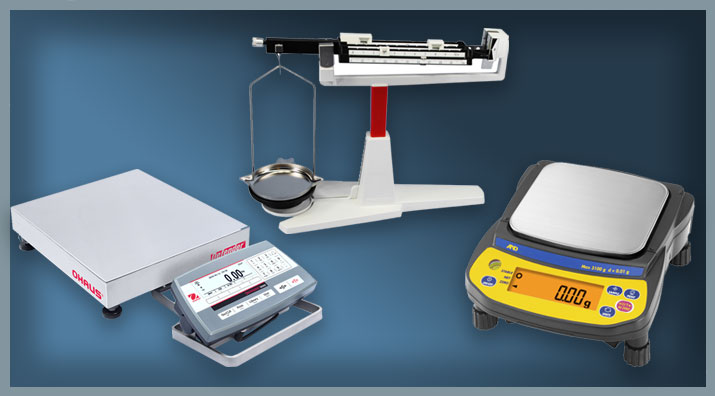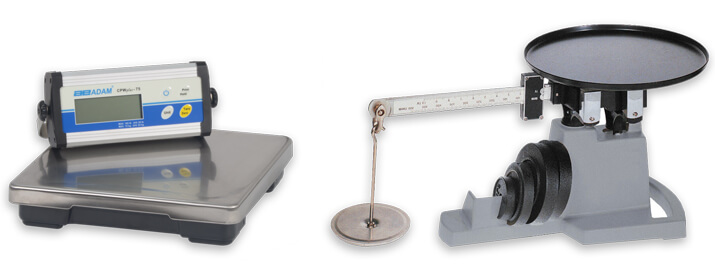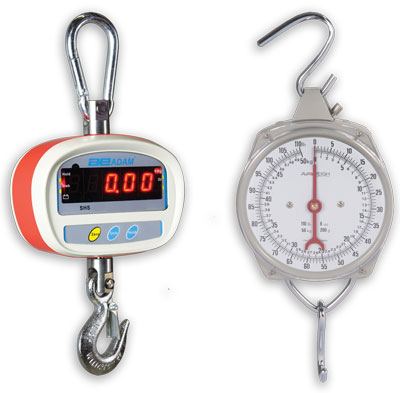
Reliable scales and balances are essential for any construction materials testing laboratory operation. Test methods for concrete, asphalt, aggregates, and soils all require accurate determinations of mass to produce accurate test results. This blog article is a guide to finding a laboratory weighing device that best meets your particular needs. Another Gilson blog article has advice on the selection of portable field scales.
Effective selection of a scale or balance requires forethought and planning. The essential considerations of capacity, accuracy, and readability are often specified in the test methods, but shopping for other features helps to find a model optimized for your particular application.
Scales and Balances, Is There a Difference?
In the strictest sense, there are defining differences between scales and balances. Balances measure mass, the amount of matter in an object, and scales measure the force of gravity acting on the mass. Calibrating a scale at a given location on Earth cancels out the effect of gravity, permitting the force measurements to be expressed as mass units like pounds or kilograms.
Balances traditionally use more intricate and complex mechanisms or sensors to precisely weigh smaller masses. Scales operate with more straightforward, less sensitive mechanisms but feature a higher capacity for heavier objects. Nowadays, innovations in electronics extract greater range, accuracy, and sensitivity from increasingly advanced sensors, blurring boundaries between the devices.
For most construction materials testing applications, there are few differences worth noting between the two classes of devices. Manufacturers and users alike often use the terms scale and balance interchangeably, and that’s how they are used in this article. The most important factor when selecting any weighing device is that it meets the capacity, sensitivity (readability), and accuracy requirements specified in the test method.
A Brief Glossary of Terms for Scales & Balances
Scales and balances are scientific instruments essential for measuring and testing the properties of a wide range of materials. Evaluating the specifications and performance of each model lets us classify them according to their overall accuracy and, by extension, their usefulness for a particular application. Here are definitions of a few industry terms commonly that define essential specifications.
- Accuracy: The degree to which a scale or balance measures and indicates the true mass of an object. Potential accuracy is determined by the design and fabrication of the unit. Operating accuracy is influenced by the unit’s calibration and the operating environment. As a rule, scales should be accurate within ±2 divisions or digits of the display when properly calibrated. Accuracy is not the same as precision, also called repeatability.
- Readability: Sometimes called sensitivity, this is the smallest change in mass that causes an incremental change in the displayed value. For mechanical scales, it is the smallest subdivision on the dial or beam of the scale.
- Linearity: Weighing successively heavier calibration masses on a balance and plotting the points on a graph defines a line that deviates slightly from being absolutely straight. Linearity is the maximum deviation of the line connecting the points between zero and maximum capacity.
- Precision/Repeatability: Determined by repeatedly weighing the same calibration mass on the scale under identical conditions. The average mass is calculated from the sum of the readings, and a smaller deviation of the readings from the average indicates greater precision.
- Reproducibility: Similar to repeatability, but the tests to find deviations in the reported weight occur under different conditions, locations, and operators.
Mechanical or Digital: Which is Better?
For many years, mechanical balances and scales were the only options for dependable determination of the mass of materials samples in laboratory environments. Early electronic digital scales were fragile, prohibitively expensive, and not always reliable.

The ruggedized construction of today’s electronic balances stands up to shock, dust, and moisture in harsh environments. They feature fast, accurate operation and offer multiple weighing units of measure. The data handling or computing and printing options they offer are not possible on mechanical units.
Scale & Balance Features: Mechanical vs. Digital
| Type | Power Source | Accuracy | Operation | Weigh-Below Option | Data Handling | Units of Measure |
|---|---|---|---|---|---|---|
| Mechanical | N/A | Adequate | Slow | Limited | Weight Indication | 1 or 2 |
| Digital | Battery or AC | Good | Fast | Yes | Weighing Taring Data Collection Internal Calibration Calculating Reporting Printing |
Up to 16 Selectable Units |
Mechanical scales are simple and robust, with no need for an electrical power supply. Still, digital balances now have the clear advantage for speed, accuracy, versatility, features, convenience, and, for many acceptable models, lower cost. Gilson still offers mechanical scales as part of our complete range of weighing products, but we recommend electronic digital models for accuracy, reliability, and workflow efficiency.
Aligning Scale Characteristics with Needs
The best quality balance serves no purpose if it is not a good match for the application at hand. Establishing some primary characteristics first narrows the field and simplifies the final choice. Gilson’s selection for digital lab scales and balances is designed to help you quickly find the models best suited for your needs. Capacity Range and Readability filters classify models by the most commonly used parameters. A separate page on our website lists mechanical balances.
- Capacity
Deciding on a maximum capacity for a new scale might not seem complicated, but it is worth some extra thought. Setting an upper limit that is too high may sacrifice accuracy or readability. However, a little extra capacity could make the device functional for other applications.
A good rule of thumb is to select a scale that weighs your heaviest samples in the middle of its range. Applications requiring enhanced readability at higher capacities also require more sophisticated load cells, which increases cost. Be sure to include the weight of scoops or containers, although many electronic scales accommodate a tare weight separately from the rated capacity.
- Readability
As noted earlier, readability is the smallest division of mass that the scale can display; however, it is not the same as accuracy. A scale with 0.1-gram readability displays the mass measurement to the nearest one-tenth gram. Scales with large weight capacities often have lower readability. Models with advanced electronics may offer better readability, but opting for extra decimal places may needlessly increase the purchase price. The scale just needs to meet the specified requirements of the test method.
- Platform Size
Dimensions of the weighing platform are often overlooked in the selection process, but daily operation may be difficult with the wrong size platform. A small platform might be fine for a flask or small container but entirely unsuitable for weighing material in a large, loose bag.
- Weighing Units
Finding a balance or scale that weighs in specific mass units used to be much more of an issue than it is today. Mechanical balances are purpose-built for measurements in a single unit of measure, although some models are equipped with a dual scale. Users of today’s modern digital models can choose to display results in a dozen or more selectable units on the same device. A scale with selectable weighing units of grams, kilograms, pounds, and ounces is suitable for weighing in most construction materials tests.
Application and Environment; Refining Your Choices
Once you have met the test method and specification requirements for a new balance, you can consider the variables on where, why, or how it is to be used. Comparing the characteristics of your front-running devices ensures satisfaction with the final choice.
|
Versatility: Is the balance needed only for a single application, or would a few more features make the device suitable for a broader range of tests? Power supply: Does the scale need to be in a particular location near an electrical outlet, or would a battery-powered model be more portable and adaptable? Workspace: Would a compact footprint allow easier operation in a confined area? Display Location: Will the dimensions or positions of the samples make the display difficult to see? Should the display be mounted in a remote location? Damp or dusty environments: Should you look for a model rated to resist environments that are dusty, dirty, or wet? |
Special Features
Digital balances have a variety of innovations to make their operation efficient and convenient. Models from different manufacturers may include innovative features or offer them as optional extras.
- Internal Calibration
Regular calibration ensures the continued accuracy of the scale. Traditionally, scales are checked for accuracy using a series of certified and traceable calibration masses and adjusting the mechanism if necessary. Internal calibration is a feature on newer balances that uses an internal mechanism or circuitry to load the balance with a prescribed weight to check and adjust calibration. If you need to track and document calibration, this beneficial feature avoids the added expense and inconvenience of separate calibration masses.
- Weigh-Below Capacity
Capability for suspended weighing allows a sample to be weighed in water for determinations of specific gravity, bulk density, or unit weight. Scales with this feature have a built-in hook on the bottom that allows the attachment of a wire to hold weighing cradles or baskets. The balance is positioned on a table or shelf with a hole for the wire to pass through. The sample is suspended in the water contained in a tank or bucket underneath.
- Overload Protection
Severely overloading a scale with too much mass can permanently damage the load cell or weighing mechanism. Balances with overload protection electronically cut off load measurements and display an error message for an overload condition.
- Elemental Protection
Scales used in rugged conditions should be protected from moisture and dirt to ensure accurate operation and long service life. Models rated for dust and moisture protection are available, and some wash-down-rated models can be rinsed with a hose. A sturdy carrying case is an option for many models for protection during transportation.
- Portability
The best location to use a scale or balance is not always next to an electrical outlet. You may need to use your scale outside of the lab. Rechargeable or replaceable battery power and a rugged carrying case allow safe operation anywhere.
- Data Collection
Some digital scales can collect weight data for printing or direct integration with software on your computer. Electronic data allows you to create and print error-free spreadsheets and reports or to translate calculations into graphs to showcase results.
Weighing Options; an Alternative to Conventional Scales
Suspension scales, also called crane scales, are sometimes overlooked for laboratory use yet still have a helpful place in construction materials testing. In the lab or field, large, bagged samples of soils or aggregates are quickly weighed using any suitable suspension point to confirm that the sample mass is adequate for testing requirements. The remote control supplied with each model allows safe operation for zeroing, taring, and selection of weighing units. Suspension Scales are exceptionally portable and valuable for accurately weighing any large, irregular item.

Maintaining Accuracy and Precision
Regular maintenance of laboratory equipment includes calibration of scales and balances. Scheduled calibration and frequent interim checks ensure accurate test results and timely records to review during audits. Gilson offers several classes of ASTM and NIST Calibration Masses from 0.001g to 250kg with traceable certification to NIST or NVLAP.

Sample Handling
Granular or powdered materials are difficult to contain for handling and weighing unless contained in a scoop, chute, or tray. Weighing and Handling Scoops are convenient for handling and preventing sample loss.

We hope this blog post has helped you find the right lab balance or scale for your testing applications. Please contact our testing experts to discuss your specific applications.
















